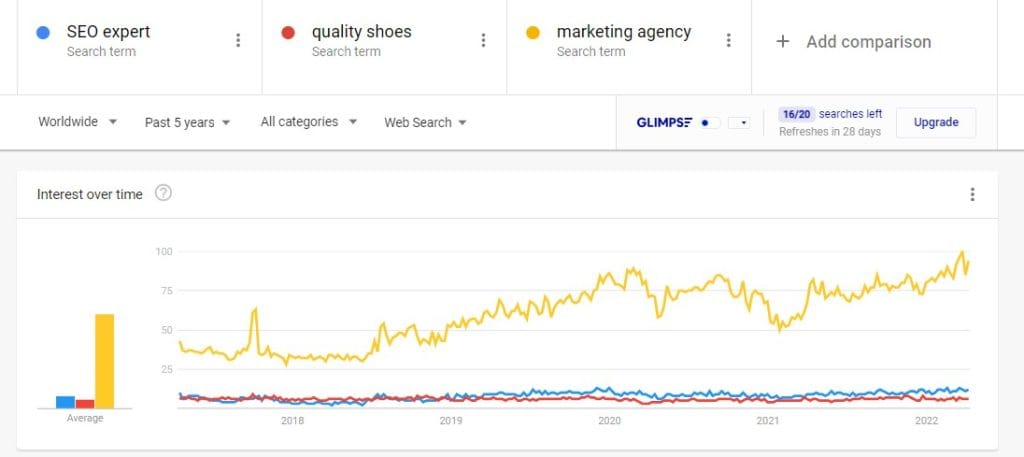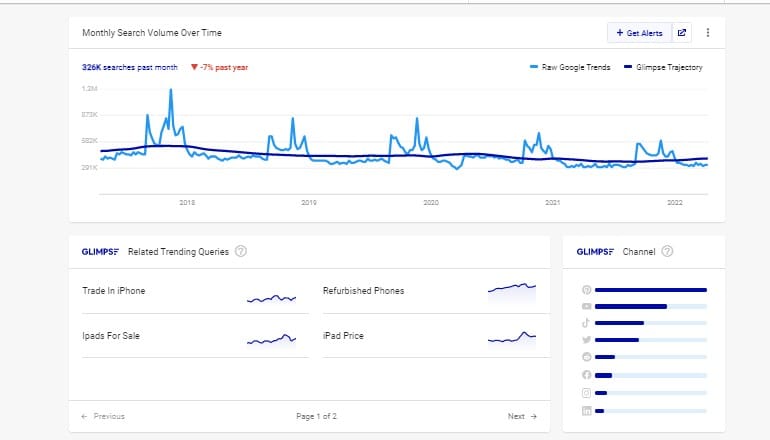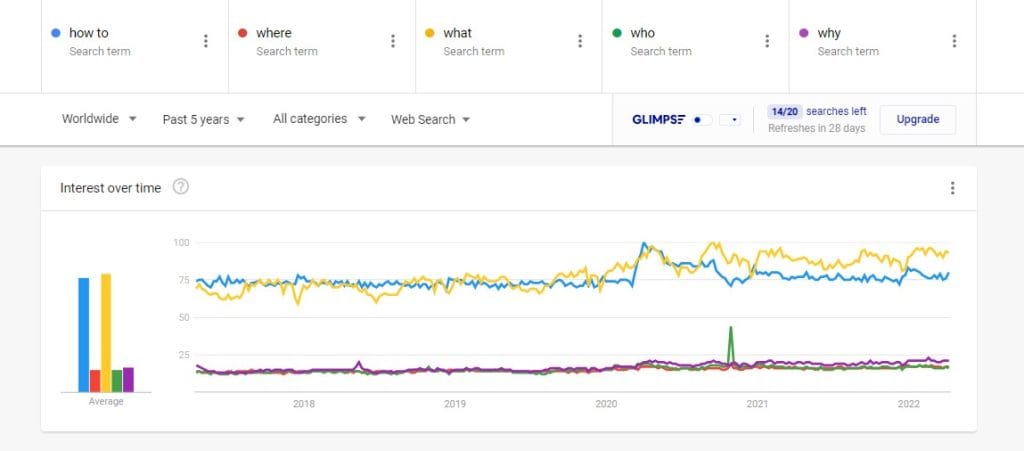To supercharge your SEO approach, learn how to leverage Google Trends to uncover hidden layers of keyword research data. You may know more about it here.
Google Trends is the only keyword research tool that uses actual Google search data to provide insights.
These seven Google Trends methods will show you how to extract genuine, accurate keyword trends that can be used to create keyword strategies for promoting websites. Learn how to use Google Trends in innovative ways to gain access to hidden insights and term volume statistics.
Google Trends’ Importance : While Google Trends is reliable, it does not provide actual traffic figures. Numbers for keyword search volume are provided by paid SEO tools. However, such figures are extrapolated from data providers’ estimates. So, while paid search engines provide keyword traffic estimates, the data presented by Google Trends is based on actual search query volume.
This is not to say that Google Trends is better than the paid keyword tools. When used with paid keyword tools, one can get an almost accurate idea of the actual keyword search volume.
There are a number of tools in Google Trends that can help with detection and segmentation of key-word data, identifying where marketing offers should be focused, as well as discovering new and trending keywords.
How to Use Google Trends for Marketing-2022
1.Increase the Accuracy of Your Data by Comparing Keywords.
On a scale of 50 to at least one hundred, Google Trends displays a relative visualization of visitors.
Because the graph is on a relative scale, you can’t tell if the trend is reporting a lot or a lot of key-word searches. This is especially valuable if you know the number of visitors from each of the other key-word words.
How to Get More Accurate Traffic Information
If you want to get a more accurate estimate of key-word seek extent, compare it to a key-word for which you already have proper extent numbers. There’s no other way to get a close approximation of the key-word scope if it’s particularly large key-word extent – by any means of evaluating your goal key-word with any key-word word which you have an concept of visitors extent.
It is not necessary for the comparative keyword to be linked. It may be something altogether else. The most important thing is to get a sense of the term volume in general.
If this volume information isn’t available, here’s a workaround for gaining a sense of search volume. Visit the Google Trends Daily Trends page to see the most popular search phrases. This page is valuable since Google provides keyword volumes in numbers, such as 100,000+ searches each day, and so on.
Here’s an illustration:
The keyword search trend for [Digital Marketing ] is moving upward, according to Google Trends. However, it does not specify by how much volume.

The Google monthly Trends page for April 23,2017 shows that searches for [Search Engine Optimization ] grew from 88k searches to 135k searches by April 16,2022

Mostly Google Trends won’t show you the exact figures, but as long as you know the amounts for one keyword, the traffic levels of the other keyword will become more understandable. Also a combination of Glimpse chrome extension +Google trends will provide you with a more accurate information .The above technique isn’t entirely 100% accurate. However, it’s sufficient to provide a rough estimate and can be used to verify extrapolated data from a paid keyword research tool.
2. Compare Keywords by Time for Audience Insights
There are mostly tow ways to look at the keyword data: stretched across over longer periods of time and shorter time periods.
Long Period Trends: You can set Google Trends to show you the traffic trends stretching back to 2016. This is valuable for showing you audience trends.
- Upward Trending Long-Term Trends: If a trend is going up this means to focus energy on creating content for this trend.
- Downward Long-Term Trends: If the trend line is moving down, then it may be a signal that audience content consumption is changing.
Consider the following five-year trend for the search term [Marketing Agency], [Quality shoes], and the website [SEO Experts]:

There’s a clear downward trend for quality shoes in all its variations. The downward trend extends to phrases such as comfortable quality shoes, quality shoes near me, and cheap good quality shoes.
It’s critical to recognize when a trend is heading in the wrong direction.
- The digital marketing started the demise of the traditional marketing.
- The digital marketing agency started the upward spiral of marketing agency
Knowing which way the wind is blowing could help a content marketer or publisher understand when it’s time to bail on marking agency and start flogging searches related to SEO expects
3.Related Questions and Topics
Related Topics and Related Queries are two of Google Trends’ most useful features.
Topics are a type of search query that has a common theme. Topics are generally language-independent, although it’s unclear whether this is the case with Related Topics.
Google claims that:
“Related Topics
Users searching for your term also searched for these topics.
You Can View by the Following Metrics
Top – The most popular topics. Scoring is on a relative scale where a value of 100 is the most commonly searched topic and a value of 50 is a topic searched half as often as the most popular term, and so on.
Rising – Related topics with the biggest increase in search frequency since the last time period.
Results marked “Breakout” had a tremendous increase, probably because these topics are new and had few (if any) prior searches.”
Related Searches
Related quires are comparable to Related Topics in terms of description.
In general, top queries are the most popular, whereas rising queries are those that are growing popular.

How to Use Google Trends for Market Research-SEO
4. Short-Term Trends Have the Potential to Generate Massive Traffic.
When looking at keyword trends in a short time frame, such as 100 days or even 30 days, you can gain useful insights on how to profit from swiftly shifting search patterns. Google Discover and Google News both receive a lot of traffic.
While Google Discover is less sensitive to trending subjects than Google News, staying on top of current events is really beneficial for attracting a lot of traffic right now through mediums such as Google Discover and Google News.
For example, two of the top trending keyword trends are mostly How To and affordable searches.
You can see which days of the week certain searches are popular when you zoom in to a 100-day view. Knowing which days of the week a specific topic generates the most interest might aid in planning when to post various types of material so that it is available when the audience is looking for it.
5.Conduct Research on Local Buying Trends. To Generate Hard-Hitting Contents,
Another very useful feature that Google Trends offers is the ability to search for distinct buying trends. With these searches, you will be able to see data related to user purchase intent for all different types of product searches. For example, you might create a search where you want to discover the products of a certain niche that people are most interested in. It doesn’t matter if it’s a beauty product, sports equipment or something else, this feature will show you purchase intent in different countries for a month that you choose.

This is a great chance to have a better understanding of your market and what clients desire to buy online. With this information, you’ll be able to figure out where your content marketing opportunities are and concentrate your efforts there. You may also attempt to improve your similar product suggestions by include items that are in high demand and promoting them through your content. Google Trends just updated their Google News Lab, which now includes assessments of current hot stories.
6. Make Geographic Keyword Data Geolocation a Powerful Keyword data
Google Trends can be utilized to evaluate which areas are ideal for promoting the site or tailoring content to specific regions. If particular types of products are popular in Ghana and Nigeria, for example, you should concentrate your advertising efforts and localized content there. Information on keyword popularity by area is useful for link building, content generation, content promotion, and pay-per-click campaigns.
Localizing content can help it become more relevant to those who are interested in it. Google ranks pages based on who they are most relevant to, thus including a geographic subtlety in your content can improve it rank for the majority of people. This is especially true if these individuals begin promoting your work on social media and blogs.
7.Uncover Search Intents With Google Trends Categories
With categories, you can find out what people are looking for, Google Trends allows you to further narrow the keyword data by segmenting it by Search Type, which is a great way to see how common different types of search intents are. When searchers are intensely focused on a single type of intent, Search Types provide insight into them.
Refining your research allows you to cut through the “noise” that may be cluttering your keyword study and get right to the signal – the most relevant data.
The data from Google Trends can be further modified by:
- Web Searches.
- YouTube Searches.
- Image Search.
- Google Shopping.
- News Search.
Searching YouTube for “how to” information’s is a great method to finding accurate results.
According to a Google Trends search for “how,” “what,” “where,” “when,” “why,” and “who,” search queries that begin with the word “how” are by far the most popular on YouTube.
Because Google Trends only allows five keyword comparisons, the next screenshot excludes that term.

Google News search trends differ greatly from those on YouTube. This is because consumers are interested in the “what” and “how” aspects of Google News. The graph above shows search queries over the last 50-90 days. When similar phrases are searched over the course of five years, it becomes evident that “what” keywords tend to rise in response to current events.
Search terms such ; What is my ip? for the past year’s generated about 1.13M search queries. All of the query filters for different search types allow you to narrow down the results to show more specific information. So give these options a shot because the information they provide may be more accurate and useful than the generic and somewhat loud “web search” version.
In Summary: Google Trends is a Useful /Helpful tool
Google Trends is a helpful tool, and with a little imagination, it may provide valuable search marketing data.
I’ve been playing around with Google Trends. I’m confident you’ll come up with new ideas to improve the way information is created and distributed online.
Have you tried any other techniques? What were your encounters with them like? Feel free to express yourself.




